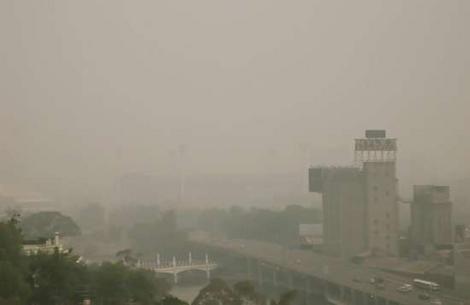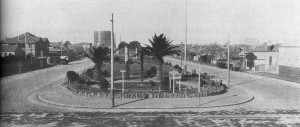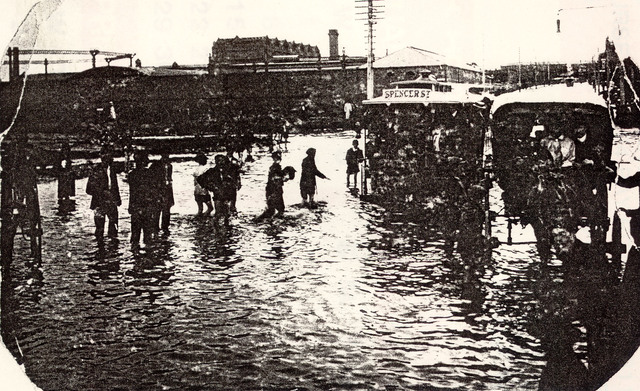Attendees at the Linking Melbourne information sessions were told that the tunnel will reduce air pollution. This is an argument often used by the road lobby.
The argument is that by taking cars of congested roads and putting them in free flowing tunnels, there will be less pollution. Furthermore, the ventilation in the tunnel pushes the pollution up the vent stacks and away from the road, bringing further benefits. Cars travelling at a constant 50km/hr do emit slightly less pollution that cars that are idling, and the mixture of pollutants is different. And vent stacks do push a lot of pollution higher into the ‘air shed’, where it has a better opportunity to be dumped somewhere else or dispersed. Also, car emissions are improving, as the fleet is renewed with stricter emission controls.
The problem with the first argument is that most of the cars will remain stuck in traffic jams. Many will be stuck in the tunnel trying to exit onto a clogged city road such as Hoddle Street. The tunnel will only add more cars and trucks to the mix.
Some of the new traffic will be queued up in a tunnel with an exit just down the hill from the Gold Street Primary School 1360 in Clifton Hill (1874, Victorian Heritage Register)

Although ventilation fans will try to push a lot of the air up the vent stacks, the trucks rushing through the tunnel will also be pushing some air pollution our the tunnel exits.
Unfortunately the Clifton Hill tunnel portal is proposed to be in a densely populated area with residents all around.
The next big problem in Link Melbourne’s argument about pollution is the trucks. Although the government is very secretive about what the tunnel is actually for, it is clear that the desire to send trucks from the port is a key driver. Trucks are not renewed as quickly as cars, so dirty trucks will be on the roads for a good while longer.
Diesel pollution from trucks was studied by the Senate Committee into Air Pollution, who’s recent report does not give much comfort to urban dwellers.
The potential negative health impacts of diesel emissions are now well known. The WHO has listed diesel emissions as a Group 1 carcinogen.[1] The International Agency for Research on Cancer (IARC), a WHO body that coordinates and conducts research on the causes of human cancer, reclassified diesel engine exhaust as a Group 1 carcinogen based on extensive evidence that exposure is associated with increased risk of lung cancer.[2] The committee heard from the ILAQH that ‘[diesel] is not a likely cause – it is a cause of cancer.’[3]
The next leg of the argument is that the tunnel will take traffic off surface roads. The weakness of this is that Alexandra Parade and Princes Street will remain three lane roads dealing with the majority of the traffic that is city bound, and clashing with north south roads which are also city bound.
The argument that the tunnel will reduce traffic on Johnson Street is not supported by the evidence of Toorak Road, which is as congested as ever, despite promises City Link would fix it.
Finally, the argument that the vent stacks will reduce pollution ignores that fact that the Gold Street vent stack is situated in a densely populated valley. Alexandra Parade was a natural water course that flowed into the Yarra River just above Dight’s falls. Alexandra Parade was known as Reilly Street until it was beautified as a depression work scheme).
Before the Reilly St drain was built, the street was an open sewer with many small bridges across it.
In 1856-7 The East Collingwood Council began to construct a major open drain along Reilly Street (Alexandra Parade) from Smith Street to the Merri Creek.
It overflowed onto the Collingwood Flat in winter and had to be deepened to ten feet (3m) when the Melbourne City Council began to extend it west.
The Argus, Tuesday 17 August 1886 reported the drain had a catchment of 700 acres in Melbourne, 120 acres in the Borough of Brunswick, 900 in City of Fitzroy and 156 in the City of Collingwood, although the principal flow was between Smith Street and the river. Topographically, it would be difficult to find a worse position for a vent stack.
The authority will argue that a taller stack will make the pollution go away. This will compete with the 160m Shot tower 1878, just across Gold St and may cause acidic erosion of that brick structure.
While the authority will put on a brave face trying to defend this indefensible project (they don’t have a choice), the truth is that no one has actually measured air pollution on Alexandra Parade, the nearest air pollution monitoring point is in leafy Alphington.
6 thoughts on “Can a road tunnel reduce air pollution?”
Comments are closed.




Yet another red herring. Tall stacks might allow pollution produced in the tunnel itself to disperse a little better but the traffic jams that will happen as the traffic leaves the tunnel and merges into monumental traffic jams heading into the city down Flemington Rd and Royal Parade in the morning or pushing slowly back towards the tunnel’s entrances in the evening, will be far worse.
The tunnel will attract additional heavy transport to Melbourne causing additional polution. Cities are designed to go to not through.
Ramon Robinson
Independent for Menzies
http://www.fb.com/RamonRobinson21C
Trains will reduce pollution and they will also help ease congestion on the roads for those who have to drive. It’s a no brainer.
Vote in this federal election for those who will force this bloody minded state government to make public its business case for this 8 billion dollar underground carpark. Make sure you go for independents and greens in the senate and put the Libs absolute last because Abbot is going to give a federal freebie of 1.5 billion dollars to his state mates for this project, NO QUESTIONS ASKED!
And tell all your family, friends and acquantices!
Why the hell are we not investing heavily in modernised railways for freight? This toll road plan will combine heavy freight traffic to and from the port with commuter traffic going into and out of the city and to the airport onto the same both the East West and City Link. As traffic trying to get off at the off ramps to go to the city back up into the tunnel the whole thing will become a monster of a traffic jam on the city’s northern edge, blocking the East West, Flemington Rd and Sydney Road. The pollution this will produce is going to enormous.